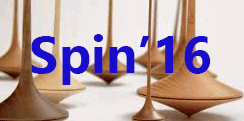Speaker
Description
The large spin dependence of the absorption cross section for neutrons by 3He gas provides a method to polarize neutron beams. For certain applications, such polarized 3He-based neutron ”spin filters” have advantages over conventional neutron optical polarizing methods. Spin filters operate at all neutron wavelengths, can cover a large angular range and/or a large energy range, and decouple neutron polarization from energy selection. Both spin-exchange optical pumping (SEOP) and metastability-exchange optical pumping (MEOP) are currently being employed to polarize 3He spin filters at various neutron facilities worldwide. I will focus on the development and application of SEOP-based neutron spin filters at the National Institute of Standards and Technology, Center for Neutron Research (NCNR) [1]. The combination of long relaxation time spin filter cells, high power diode lasers spectrally narrowed with chirped volume holographic gratings, and the use of Rb/K mixtures have allowed us to reach 3He polarizations up to 85 % in spin filter cells ≈1 liter in volume [2]. Studies have revealed limits to the achievable polarization from temperature-dependent relaxation [3] and unexplained magnetic field dependence for relaxation in SEOP cells [4]. Applications include neutron scattering methods such as triple-axis spectrometry and small angle neutron scattering [5], and fundamental neutron physics. A measurement of the spin-dependence of the neutron-3He scattering length was performed with a small, polarized 3He cell in a neutron interferometer and a 3He spin filter for accurate neutron polarimetry [6]. Use of spin filters in high flux neutron beams have revealed beam-induced alkali-metal relaxation and long term effects on SEOP spin filter cells [7]. A recent focus has been application to wide-angle neutron polarization analysis [8], for which we have obtained nearly 80 % 3He polarization in unique ”horseshoe” shaped cells to analyze a 220◦ angular range. We are also currently pursuing application to polarized neutron imaging [9].
References
[1] W.C. Chen et al., Journal of Physics: Conference Series 294, 012003 (2011).
[2] W.C. Chen et al, J. Appl. Phys. 116, 014903 (2014).
[3] E. Babcock et al., Phys. Rev. Lett. 96, 083003 (2006).
[4] R.E. Jacob et al., Phys. Rev. A 69, 021401(R) (2004).
[5] W.C. Chen et al, Journal of Physics: Conference Series 528, 012014 (2014).
[6] M.G. Huber et al, Phys. Rev. C 90, 064004 (2014).
[7] E. Babcock et al., Phys. Rev. A 80, 033414 (2009);
[8] Q. Ye et al, Physics Procedia 42, 206-212 (2013).
[9] D.S. Hussey et al, Physics Procedia 69, 48-54 (2015).
